
Love at First Sight
When we think of the Maldives, the first things that come to mind are paradise islands, atolls, luxury resorts, honeymooners… OK, that too. But in an Eden like this, it’s easy to imagine the alternative paradise wecan find underwater. And it doesn’t disappoint.
We are literally in the middle of the Indian Ocean, but lucky enough to be relatively close to India, about 450 kilometers to the south. This makes it an easy challenge to reach by plane. Anyway, the international airport is connected abroad and many flights land everyday.
Geological chance has created an underwater mountain range more than 900 km long from north to south, which corals have brought to the surface. A peculiar form of a double chain of atolls, with more than 1.000 islands in total. Actually, it is not the islands themselves that are most interesting for diving, but the “almost” islands that remain deep enough to support incredible underwater life. There are different names for these formations depending on their peculiarities, but the one that resonates the most is “Thila”, referring to a coral formation whose top is a few meters below the surface.
With this setting, we can understand the richness found in the depths of these atolls. The good conservation intentions of the local government help to keep this wonder of nature in good condition, despite the resorts and the thousands of divers who pass through each year. It is also in our hands to achieve this. Later on, as always, we will give you some interesting tips so that together we can help to conserve this and all the corners of our planet.
Love at First Flight

No matter how much we’ve read, seen photos and satellite views, we can’t get an idea of what’s here until we fly over it for the first time. If there is one reason why I always choose a window on a plane, it is so that I can have the opportunity to see this kind of beauty from the air. I prefer to be more cramped during the flight so that I can observe the turquoise blue and green waters of the atolls and vegetation-strewn islands with my own eyes from the air as the plane makes its approach maneuver.
The Maldives is one of the most luxurious destinations on the planet. The exception to this rule is the arrivals area of the airport. Certainly, this area is very simple, but functional nonetheless. From early morning it becomes a bustling flea market, where tour operators scramble to meet and greet their guests. Most common for divers are liveaboard safaris, where you are met at the airport and embark directly onto the dock next to the airport. It is advisable to make sure that our tour operator includes this, as it makes all the logistics much easier. If we want any extension to the liveaboard, we would probably prefer to do it after the dive.
Love at First Night

In our case, I must confess that Subnomadas and BCN Diving made the best possible choice. We spent 6 days on board Sachika, the best rated boat in recent years for diving safaris in the Maldives. Understandably at a price acceptable to the average diver, of course. It’s amazing to embark on a 5-star floating hotel, with spacious, clean rooms and a buffet with good quality food and spacious decks to enjoy free time between dives.
Beers are not included, but they are very reasonably priced for a boat like this in the Maldives. We don’t want to encourage alcohol consumption 😉 just to say that they are less than half the price of a resort here.

-Very carefully…
– OK! Please, can I have a Corona?
In addition to all these conditions, which in themselves greatly enhance the experience of a trip, the great advantage of this type of safari is the auxiliary boat. Everyone refers to it by the local word for the traditional fishing boats: “Dhoni”. The dhoni is of considerable size, big enough to hold about 20 divers and the guides, with all their equipment and compressors. This avoids the annoying noise while refilling the tanks during the time we are on board. In addition, and most importantly in my opinion, it saves the divers all the hard work of carrying tanks and setting up the equipment, which really enhances the diving experience! When you board the dhoni, all you have to worry about is checking the Nitrox. Well, okay, you have to put the suit on by yourself, and even then, if you get stuck with it, you always have someone from the crew ready to help you. I must say that the crew of Sachika is the most efficient and helpful I have ever seen.
“Jump negative, think positive”
With their permission, I have borrowed this moto from Top Class Cruising, the company that owns Sachika. It perfectly expresses the philosophy I think we should apply in the Maldives.
For those of you who are not used to “negative jumping”, this means jumping off the boat with the jacket completely deflated and starting to descend directly without staying on the surface after the jump. The reason for this practice is the strong currents that we usually find in these waters at many dive sites. It is better to descend directly to keep the group together and meet at the bottom at the exact point where you want to start the dive.
For those not used to “thinking positive”, for me personally it means, apart from a philosophy of life, enjoying all the wonders that the Maldives have to offer, despite some inconveniences we may encounter. Yes, in paradise there are downsides too, not everything is going to be perfect. And I don’t mean apples and snakes.
The currents are often strong in some places, due to the fact that we are in the middle of the ocean and the islands and atolls intensify that effect. In return, we have a thriving marine life that would be impossible without them. Sometimes visibility is not optimal, especially inside the atolls, as water turnover is lower. We must understand that these suspended particles are often nutrients that attract countless species that we can enjoy thatotherwise would not be there. And if anyone thinks that sometimes it rains too much – they are called monsoons – it is thanks in large part to the incredible tropical temperature of about 30 degrees Celsius that we can enjoy all the time.
Follow the leader

We have all dived in a group of 10 or 12 people following a guide. It is certainly not very comfortable and safe. Instead, Sachika always has 4 dive guides per dive. That means, groups of 5 divers. This does make a radical difference to the underwater experience. It ensures safety and a good underwater guided tour.

All the guides are very experienced and attentive to your group. It is important to remember that no matter how many dives we have done, we will never know more about these dive sites than they do. This seems obvious, but it is important to remember, especially in waters like these, which often have particular conditions. For example: currents, anchor points, depth and no deco time, not disturbing the animals and keeping the cleaning stations clear (more about them later).
The guides do an incredible job of showing us the greatness of the underwater world. If we follow their instructions, our dives will be much better, no doubt about it.
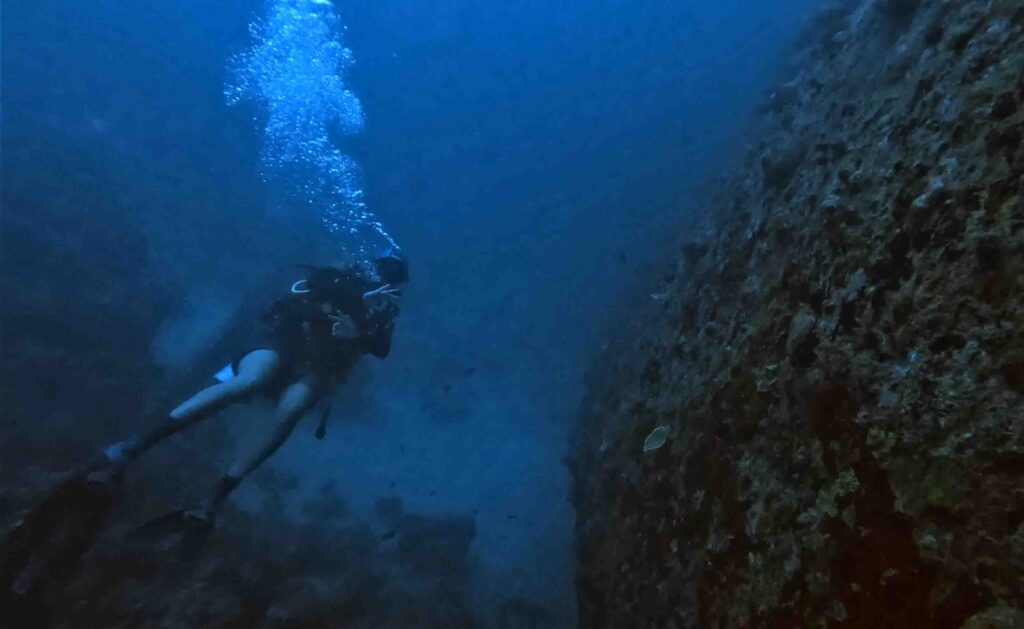
Last but not least, at the end of each dive, the guide inflates a buoy where his group is and the dhoni comes to pick us up. This saves us a lot of swimming, which will come in handy on the next dive if we have to swim against the current.

Love at First Dive
Below, we are going to review some of the most outstanding dives in the Central Atolls of the Maldives, which have delighted us during an intense week, which has seemed like a month to us. There are many and very diverse and depending on the time of the year and the weather and environmental conditions. Our guides will always choose the best option.
KHUDIMA WRECK

I have decided to start with this dive site because I was lucky enough to get this stunning photography, which for me reflects one of the wonders that diving has to offer.
Personally, I am fascinated by the feeling of literally being in another world , of flying in a parallel universe. Even though we have the technology to breathe and move almost as if we were on land, it is not our world. We are strangers in a universe to be explored and discovered. Yes, before diving we have attended a briefing, we have a dive plan, we know what we might encounter. However, whenever we head out into the blue, we are overcome by a feeling of entering an infinite world to be discovered. We know that we will always find something new, something known or unknown that will surprise us. This diver flying over the sunken ship while heading towards the deep blue, transmits to me that magic that I feel every time I dive. The magic of being able to fly in another world and discover something new on each dive.
On the other hand, wrecks give me a fascination that I can’t explain. I think it is because it is like a “foreign body” that comes from another world, ours on land, and is found in the parallel universe of the seabed.
This ship was sunk on purpose to create a dive site as well as an artificial coral reef. In little more than 30 years, it has been colonized by all kinds of corals, which grow on it as if it were a natural atoll.

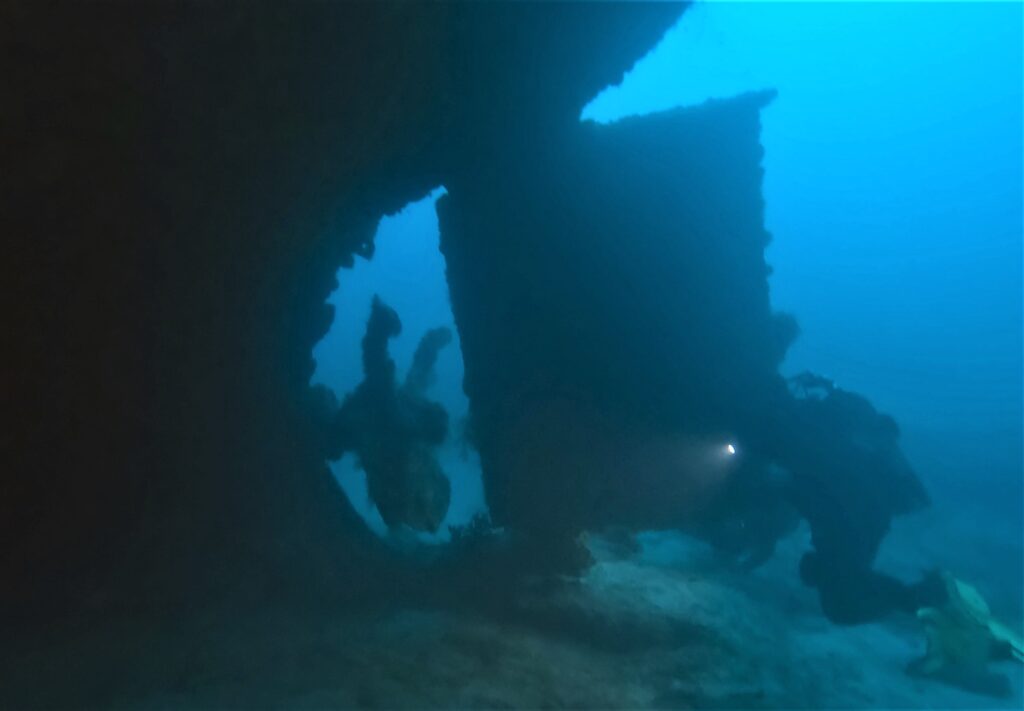
Marine life can be observed especially on the hull, hidden among its gaps and corals. If we are lucky, we may also come across, for example, a stray stingray that wanders over to take a peek, while we are busy on our interesting mission to explore this old hull.
In the case of the Khudima, the low visibility accentuates the feeling of entering the unknown. The immense blue hue is due to a strong current. You have to swim a long way down to the bottom, down to about 30 meters. We can go all the way around the outside before entering through one of the specially created openings, and finally explore the deck.

The great advantage of “artificial” wrecks is that they are designed and prepared to welcome the divers. In this case, it has large openings in the hull for comfortable entry and exit and a completely uncluttered interior to avoid potential problems. The crane on the deck, in front of the bridge, puts the icing on the top of the cake, giving a final touch of charm to a simple wreck, but one that is well worth enjoying.

MOOFUSHI CORNER
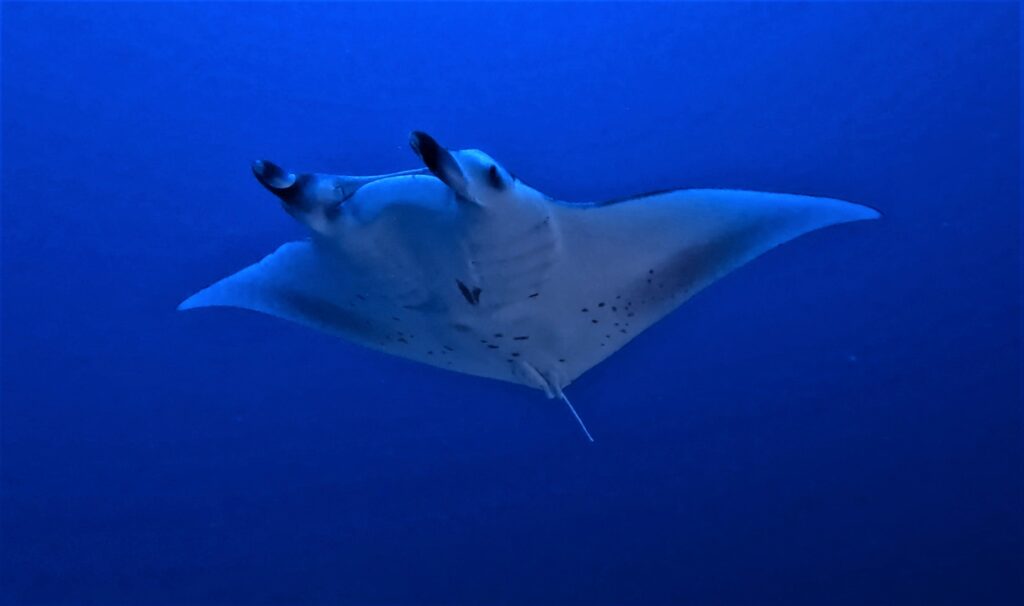
Please, if you are only going to do one dive in the Maldives, let it be this one, or at least one that has a manta cleaning station. It is a sight not to be missed. A cleaning station is a location that houses certain fish that help the mantas to clean themselves, so they come frequently and can hang around in that space for a long time. There is room for more than one manta ray, of course, so the show is guaranteed. This privileged spot allows us to observe them in all their magnificence time and time again. I was going to say until we get bored, but I don’t think anyone can get bored of seeing such a spectacle. Or rather, until we run out of air.

There are two species that fascinate me in the underwater world: dolphins and manta rays. Dolphins for their intelligence and friendliness and manta rays for their serenity and majesty. Both have an amazing quality in common: they are “human-friendly” 😊. Fortunately, most of us humans who are able to go a few meters below the surface have learned to respect and care for them and for all species in general. Thanks to this and to their innate curiosity, especially in the youngest specimens, we will be lucky to have them approach us without any fear. If they come within a few centimeters of us, we should not touch them if they do not, just let them play with us and enjoy their company.
Our guide will remind us to stay on the lower part of the reef, surrounding the cleaning station, in order to have a better observation. Never invade it or chase the mantas. This will scare them away and we will then only be able to observe them for 2 minutes instead of 20 minutes. Many of us have got excited watching or filming them and lost track of space-time a bit. If this happens to us and we end up invading the station, we must remember that it is best to leave as soon as possible to avoid scaring them away and to keep them with us for as long as possible.

This dive starts a few meters from the cleaning station, jumping in negative as always when there is current. At this point, the bottom descends rapidly and we should not go deeper than 30 meters. At this depth and drifting, we will be able to see quite a few sharks in the blue. They are not easy to get close to here, so it is enough to see them as a backdrop to what comes next. We will have other opportunities to see sharks up close. On this dive, the manta is the undisputed star of the party.

HULUMALE WALL
The wealth of marine life hidden beneath these waters is incredible. The capital, Male, is a not-too-big island with buildings to overflowing. It’s one of the most densely populated cities in the world. The airport is located on the nearest atoll and is connected by a long bridge. Merchant shipping is busy in this area.


However, before we set off on our safari, on the surface and without having set sail yet, we can see dolphins jumping through all this human-made commotion. Moray eels, turtles and rays can also be seen next to a grey jetty belonging to a fish cannery, which we will see on our last dive before heading home.

Literally next to the airport, we dived in Hulumale, the territory of the stingrays. There is something amazing about every dive on these islands. Here we can see so many rays together that our eyes are incapable of taking them all in, let alone our cameras. Even with a fisheye you can’t frame them all, when they decide to approach our group forming a huge mosaic. It seems as if they want to tile the bottom of the ocean as they brush against it and kick up sand with their delicate, undulating movements. On the contrary, they become like the finely tangled tiles of a roof when they pass over us and almost hide the sunlight.
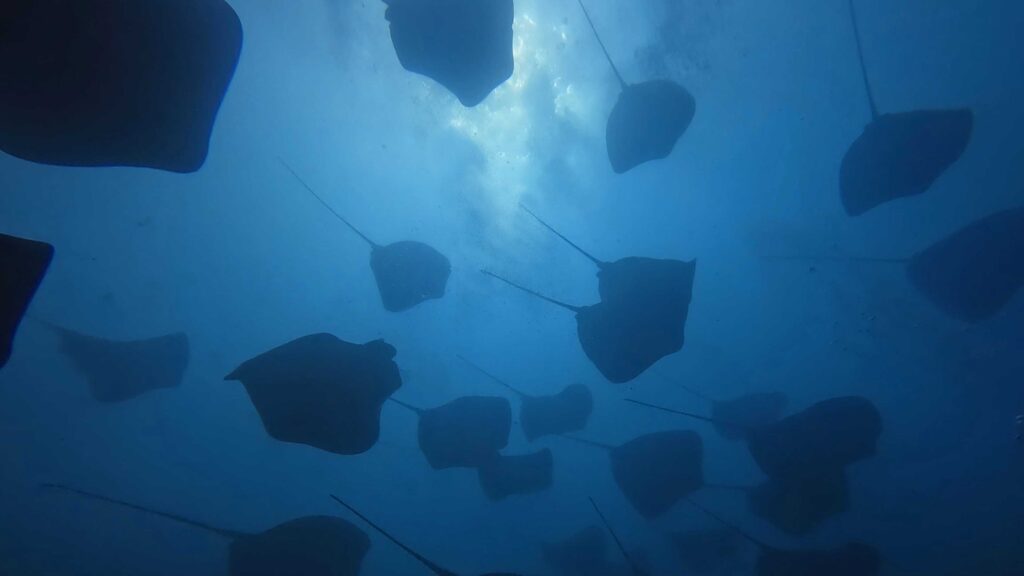
It is difficult to express in words what it feels like to be underwater surrounded by all these wonders, not even when I am in a poetic vein. I was lucky enough to be able to capture them in a few pictures, although it was impossible to get them all in the same photo. The videos will come in version 2.0 of SportsMarketMagazine.com 😊, and not all of them will be there either…
ALIMATHAA JETTY
Many night dives end up reminding me of a discotheque, where there are a lot of spotlights all over the place, moving all around. In this case, even more so, because the floor was full of sharks 😉.

Joking aside, this is a memorable dive. We are in the classic night dive environment: a shallow sandy platform where it is impossible to get lost or end up in the depths. However, this one has a very special charm. Being surrounded by nurse sharks is a feeling that is hard to match. In general, being surrounded by sharks is, even more so if they come as close as they do and you know there is no danger. No matter where you look, there they are, brushing against you as they glide gently over the bottom. We can also see them at the end of the dive, circling the boat all night long – is that why they are called nurse sharks?

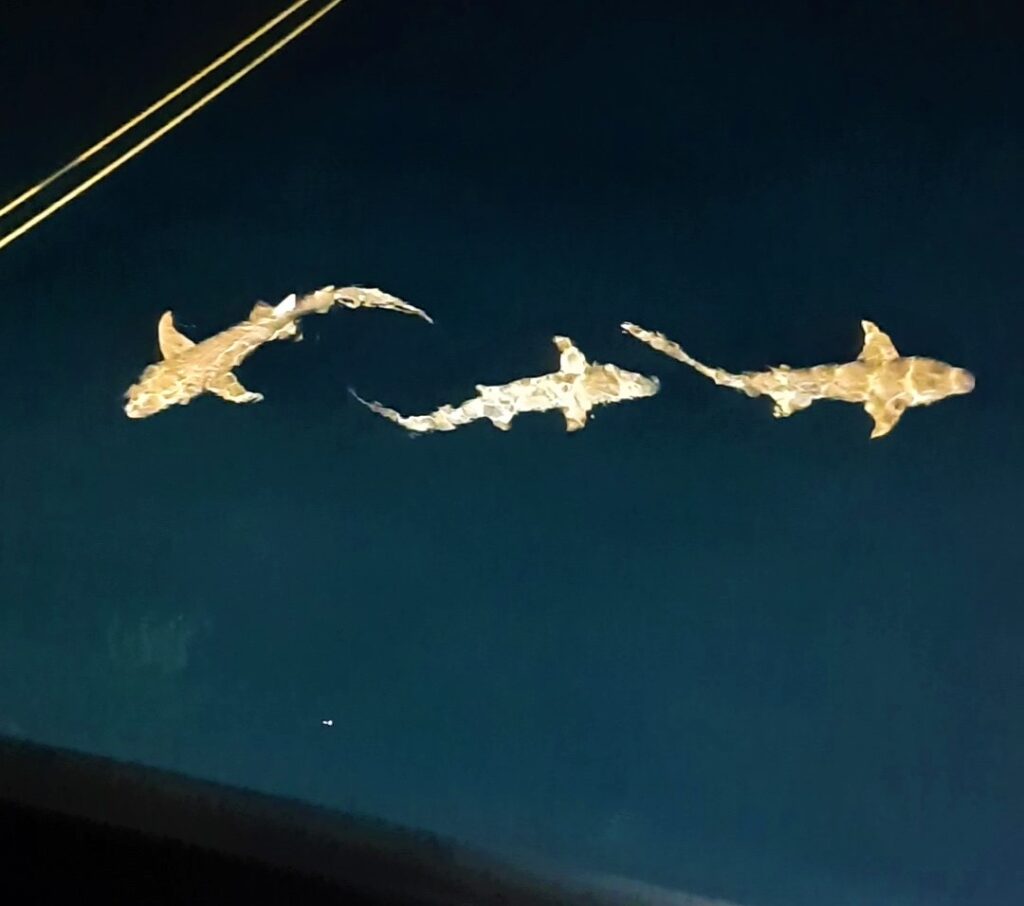
A few wandering stingrays add an alternative touch to the nurse territory, but the stars here are the sharks. We are shark whisperers…
